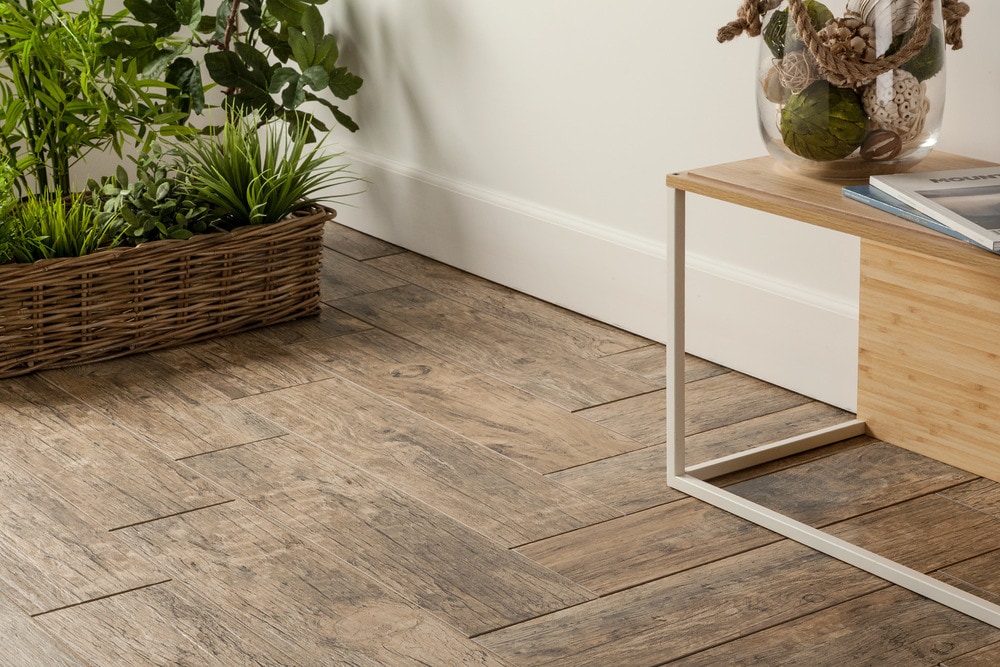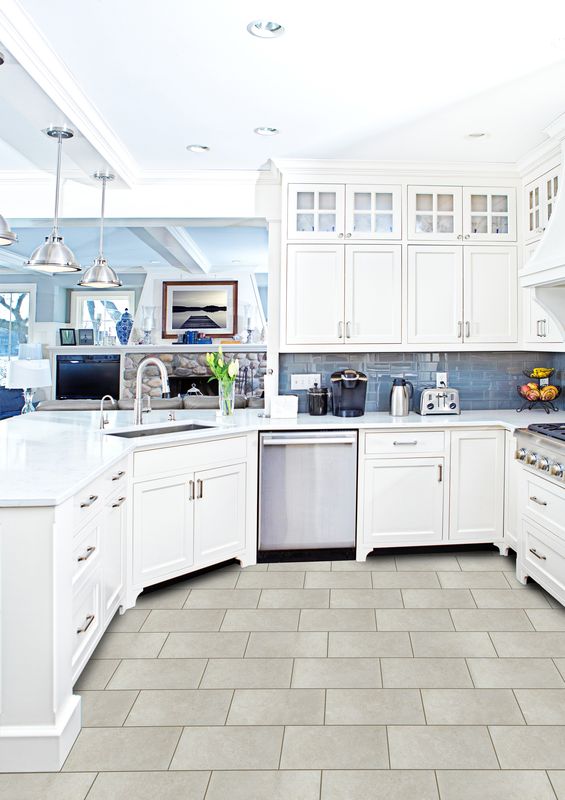How to Prepare Different Subfloors for Tile Installation

Ceramic and porcelain tile are among the most rigid materials for flooring. They require a subfloor that’s designed to account for this, without any fluctuation or movement. If ceramic or porcelain tiles are installed on an uneven surface, there is the risk they may crack or loosen. Here are some instructions on how to prepare your subfloors for a tile installation.
1. Laying tile flooring over concrete
- Repair all cracks and uneven patches in the concrete subfloor prior to the installation – especially important if the tile is being directly bonded to the concrete.
- In case of subfloors with large cracks, consider the possibility of removing a large section of concrete slab and replacing it with a new one instead of patching all the cracks.
- For bad cracks in the concrete slab, smooth it with concrete filler, or similar compound.
- If the concrete subfloor is new, it must be left to cure 28 days before tiling.
- Cleanliness is paramount. Besides any surface materials, be sure to remove any grease stains, or other substances that have stained the slab as best you can.
- Cement backer board can provide a solid, flat surface to install tiles on if you have a wood subfloor.
2. Laying tile on plywood
- A plywood subfloor must be structurally sound and able to support the installation. Tile floors are heavy and tile is a hard material. It will break or dislodge if the surface bends under the load.
- Remember that you need a very flat surface to work on. If needed, sand the plywood down to level the subfloor.
- Plywood must be installed over an adequate subfloor and must be at least 1 1/8″ thick when combined with the subfloor. Interior-grade plywood and particleboard are not considered strong enough for a tile installation.

3. Can you lay tile over linoleum or vinyl?
- Yes, if you are transitioning from non-cushioned vinyl or linoleum flooring that is structurally sound and free of excessive movement, the old vinyl or linoleum can act as an appropriate subfloor for tile.
- No, cushioned vinyl is not an appropriate subfloor. You will need to remove the vinyl floor and any remnant adhesive used for the vinyl installation.
- In some cases, you will be able to remove the vinyl itself, but not the adhesive. Use the type of thin set that is recommended by the backer board manufacturer.
- If it seems difficult, you might want to lay down a backer board with thinset.
4. Can you tile over tile?
- Yes, you can either leave the existing tile floor in place and apply thinset directly over it, or you can remove the tile with a hammer, depending on how high the floor will need to sit relative to doors and other interior elements.
- If the existing tile floor is set over a mortar bed, it may be hard to remove the tiles without removing a lot of the mortar bed.
- If you’re installing directly over the old tile flooring, rough up the existing tile with sand paper. Clean with a degreaser and test a small area overnight for bonding.
- Also, check the height of the floor with the height of doors and cabinets. Any good thinset can be used to install your new floor.
Unsuitable subfloors for tile
Subfloors to avoid for tile installations are those that tend to flex, expand, contract, or warp. Any excessive movement will loosen the tile and pop the grout. Unsuitable subfloors must be replaced or covered with a suitable underlayment. Here’s a list of no-go subfloors:
- Cushioned vinyl
- Perimeter installed vinyl
- Single layered plywood
- Flake board
- Particleboard
- Chip board
- Hardwood (strip) flooring
- Luan plywood
- OSB boards
- Masonite
- Sheet metal
Still looking for the right tile for your renovation project? Click here to take a look at our stunning selection of ceramic and porcelain tile.

John
I have 2×6″ floor boards, which appear stable and level, with a small exception around a toilet where boards were replaced and are about 1/16″ lower than surrounding boards.
Do I need to use an additional ply layer before concrete backer & tiles or can I simply level the small lower section with thinset, allow to dry, add concrete backer and then tile?
Paula
I have engineered hardwood on a concrete slab. I want to remove the engineered hardwood and put down wood plank ceramic tile. Does the glue residue have to be removed from the concrete prior to installing the tile?
Sandy
Have a 1st floor condo with a concrete floor that is above grade because it is over the garage.
Is it ok to lay porcelain tile directly on concrete. Looking at 8″X45″ tile. Use 1/16″ or 1/8″ spacers?
Dan
Hi there,
I’m in the process of redoing my kitchen. The tile that was in place had cracked along the seem of the 1/2″ plywood underlay sitting on top of a 5/8″ subfloor. The old tile were some type of natural stone. I consulted with the tile shop where I bought my new tile and he suggested that perhaps the grade of ply was not adequate. He suggested I remove the 1/2″ ply and put down a new layer of 5/8″ underlay on top of the existing 5/8 subfloor making sure not to overlap joints. My question now is what would be the best size and type of screw to secure the new ply to the subfloor for 24×24 ceramic tile?
Mark
We took up old ceramic tile (original with a 20 year old house) and found no cement board or other underlayment material underneath. However, I did find that the previous installer had put another sheet of 1/2 plywood over the 3/4 inch plywood subfloor. Is this adequate to install new 12 x 24 inch porcelain tiles ? Or, do I need to get rid of that 1/2 plywood sheet and install cement board, or something like Ditra?
BuildDirect Product Expert Team
Hi Mark,
You will need to at least put down a concrete back board. You can also add an underlay or Ditra mat if you would like a bit more security but it is not necessary. Please let us know if you have any other questions!
Jim
I have a 1 1/4″ plywood subfloor installed on 2 x 8 joists on 16″ centers. I am considering porceline tile. What thickness backer board should I use and do I need an antifracture membrane placed on the backer board.
BuildDirect Product Expert Team
Hi Jim,
Thank you for getting in touch! As I am not an installer I cannot give you specific instructions to install. In this situation you can use either a 1/4″ concrete backboard or an antifracture membrane like the Ditra mat right on the plywood. You will need to make sure the subfloor does not move or bend. Please let us know if you have any other questions!
ovoke terrence
please, I want to tile my floor..its a new apartment that has never been tiled. It has concrete floor..can I get the processes involved?
BuildDirect Product Expert Team
Hi Ovoke,
Thank you for your inquiry. You can install tile over a concrete floor. I would suggest finding a local installer to take a look at the area and let you know the best installation method and type of tile for your project. Please let us know if you have any other questions!
Chris
Hi, I’m renovating my bathroom and had a question about the sub flooring needed for the new tile. When I took the old tile floor out there was a 1″ thick concrete base on top of the 3/4 plywood floor. I removed the concrete and left the plywood because it’s in good condition. I assume I need to add an inch of subfloor to replace the concrete. I was thinking half inch ply on top of the 3/4 and then Hardi board on top? Is that okay or is that too many layers? If it is okay, how should the layers be fastened? Thank you
BuildDirect Product Expert Team
Hi Chris – thanks for reaching out to us! You would need at least 1/2″ concrete backer board that would require thin set and to be screwed down. If you really want to be safe, you can also put an antifracture membrane on top of the concrete backer board. The antifracture membrane would assist with any movement in the subfloor, where the backer board assists with any flex in the subfloor. Any movement in the subfloor, can cause the tile to crack or break. Please let us know if you have any other questions!
STEVE
I was wondering if I could install tile over my linoleum flooring? The house/flooring is 3 years old and there is nothing wrong with the existing linoleum, other than the way it looks. Thanks
BuildDirect Product Expert Team
Hi Steve – thanks for reaching out to us! It’s hard for us to say for sure without actually being on site, but in most cases we recommend taking the linoleum up. Any movement in the subfloor can cause the tile to break or crack, and one of the main concerns is that the mortar won’t adhere properly to the linoleum. Please let us know if you have any other questions!
DBird
I have a floor with TJI’s 24″ OC, 3/4″ T&G and 1/4″ luan with sheet vinyl. I want to install tile. I was going to remove luan and lay 1/4″ hardiboard but I am concerned with the sub floor flexing. What would you recommend?
Glen Harter
I current have 5/8 plywood over 16″ o.c joist. I will be installing both mosaic tiles and a floating laminate floor. I have a way of transitioning between the two. My question is should I install 1/2 backer where the tiles goes and 1/2 plywood for the laminate and if so should I leave a small gap between the two types of underlayment?
BuildDirect Product Expert Team
Hi Glen. Thanks for reaching out to us! Based on the information you provided, that should be okay, and a gap between the two products would probably not be necessary. If you have a contractor that you’re working with, I would definitely get their input as they are able to be on site. Please let us know if you have any other questions!
Sudath Jayasinghe
What is the disadvantage using cement grout using on concret floor before made the tile bed as a adhesive, is it highly necessary to use any other adhesive
BuildDirect Product Expert Team
Hi Sudath. Thanks for reaching out to us! Sorry, I’m not sure if I’m understanding your question. Are you talking about installing concrete on concrete to make it level? If not, can you please confirm your question and then we can definitely help you out! Thanks so much.
BuildDirect Product Expert Team
Hi Willard,
Thank you for getting in touch! Unfortunately you are not able lay tile over laminate flooring. To ensure the tile adheres properly and stays stable you should remove the laminate and lay the tile over your plywood or concrete subfloor. Please let us know if you have any other questions!
willard crowley
can you lay tile over laminate fooring.